- What causes cucumber leaves to turn yellow
- Nutritional deficiencies
- Overwatering
- Pests
- Diseases
- Environmental factors
- Conclusion
- Lack of nutrients
- Pests and diseases
- Pests
- Diseases
- Overwatering
- Soil pH imbalance
- Causes of soil pH imbalance
- How to test soil pH
- How to adjust soil pH
- Preventing soil pH imbalance
- Conclusion
- Inadequate sunlight
- Environmental stress
- 1. Temperature fluctuations
- 2. Inadequate watering
- 3. Nutrient deficiencies
- 4. Pests and diseases
- 5. Overcrowding
- Improper pruning
- Solutions to yellowing cucumber leaves
- “Question-Answer”
- Why are my cucumber leaves developing a yellow border?
- What should I do if my cucumber leaves have a yellow border?
- How can I determine if the yellow border on my cucumber leaves is due to a nutrient deficiency?
- Can overwatering cause a yellow border on cucumber leaves?
- Is it possible for a yellow border on cucumber leaves to be a symptom of a disease?
- How can I prevent a yellow border on my cucumber leaves?
- Are there any natural remedies I can use to treat a yellow border on cucumber leaves?
- “Video” THE LEAVES ON CUCUMBERS ARE YELLOWING URGENTLY TAKE ACTION OTHERWISE THERE WILL BE NO HARVEST
If you’re noticing a yellow border on the leaves of your cucumber plants, it’s a clear sign that something isn’t quite right. Luckily, there are simple steps you can take to address this issue and ensure your plants stay healthy and productive. By understanding the potential causes and implementing proper feeding techniques, you can help your cucumber plants thrive and avoid further leaf discoloration.
One possible cause of yellow borders on cucumber leaves is a nutrient deficiency, specifically a lack of nitrogen. Nitrogen is an essential element for plant growth and is often needed in higher quantities by cucumbers. To remedy this deficiency, you can apply a nitrogen-rich fertilizer to your plants. This will help replenish the necessary nutrients and encourage healthy leaf growth.
Another potential cause of yellow borders is overwatering. Cucumbers prefer a consistently moist but well-draining soil. If you notice yellowing leaves, check the moisture level of the soil. Overwatering can lead to root rot, which can impact the overall health of the plant. Adjusting your watering schedule and ensuring proper drainage can help prevent this issue and promote green, vibrant leaves.
In addition to these steps, be sure to monitor your plants for any signs of pests or diseases. Aphids, mites, and fungus can all contribute to leaf discoloration. If you suspect a pest or disease issue, promptly treat your plants with an appropriate pesticide or fungicide. This will help eliminate the problem before it spreads and causes further damage.
With these quick steps, you can effectively address the issue of yellow borders on cucumber leaves and provide your plants with the nutrients and care they need. By taking proactive measures, you can enjoy a bountiful harvest of healthy and vibrant cucumbers.
What causes cucumber leaves to turn yellow
Turning yellow leaves on cucumber plants can be a sign of several issues, including nutritional deficiencies, overwatering, pests, diseases, or environmental factors. It’s essential to identify the underlying cause to take appropriate action and restore the health of your cucumber plants.
Nutritional deficiencies
Cucumber plants require a balanced supply of nutrients to stay healthy and thrive. Yellowing leaves may indicate a lack of essential nutrients, such as nitrogen, iron, or magnesium. Conduct a soil test to determine if your soil lacks these nutrients and apply appropriate fertilizers or amendments accordingly.
Overwatering
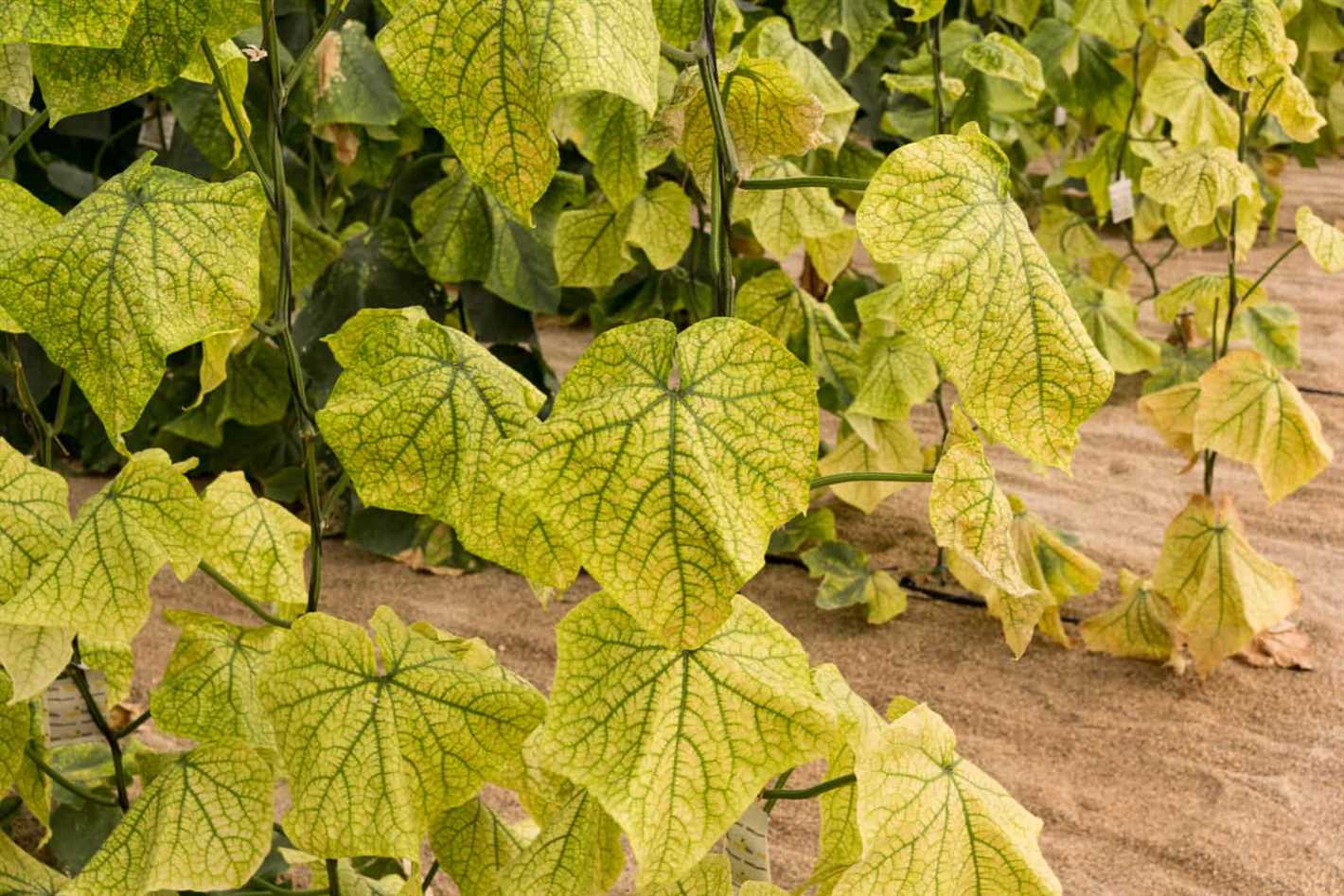
Excessive watering can lead to waterlogged roots and poor nutrient uptake, causing the leaves to turn yellow. Ensure proper drainage and only water your cucumber plants when the top inch of soil feels dry. Avoid overwatering and provide adequate airflow around the plants to prevent moisture-related issues.
Pests

Pests such as aphids, mites, or cucumber beetles can damage cucumber plants and result in yellowing leaves. Inspect the leaves, stems, and undersides for any signs of pest infestation. If pests are present, use organic pest control methods or insecticidal soaps to eliminate them and protect your plants.
Diseases
Cucumber plants are susceptible to various diseases, including fungal, bacterial, or viral infections. Yellowing of leaves could be a symptom of a disease such as cucumber mosaic virus, bacterial wilt, or powdery mildew. Remove and destroy affected plants or parts to prevent the spread of the disease. Ensure proper sanitation and use disease-resistant varieties when replanting.
Environmental factors
Environmental stresses can also cause cucumber leaves to turn yellow. Excessive heat, cold temperatures, high humidity, or fluctuations in moisture levels can affect plant health. Provide shade, adequate ventilation, and consistent watering to minimize the impact of these factors on your cucumber plants.
Conclusion
Yellowing leaves on cucumber plants can be a sign of various issues. By identifying the underlying cause and taking appropriate action, you can help restore the health of your cucumber plants and ensure a bountiful harvest.
Lack of nutrients
One possible reason for yellowing cucumber leaves is a lack of nutrients in the soil. If the leaves have a yellow border, it could indicate a deficiency in essential nutrients like nitrogen, potassium, or magnesium.
Symptoms:
- Yellowing of leaves, particularly along the edges
- Stunted growth
- Pale or yellowish color
Solution:
If you suspect that your cucumber plants lack nutrients, there are several steps you can take to address the issue:
- Soil testing: Conduct a soil test to determine which nutrients are lacking in your soil. This will help you understand which nutrients need to be added.
- Fertilizer application: Once you know which nutrients are deficient, apply a balanced fertilizer that contains the necessary nutrients. Follow the package instructions for proper application rates.
- Organic amendments: Consider adding organic matter, such as compost or well-rotted manure, to enrich the soil and improve nutrient availability.
- Foliar feeding: If the nutrient deficiency is severe, you can provide additional nutrients through foliar feeding. This involves spraying a nutrient solution directly onto the leaves, allowing the plants to absorb the nutrients.
Prevention:
To prevent nutrient deficiencies in cucumber plants, it is important to maintain a balanced nutrient supply in the soil. Regularly test the soil and adjust nutrient levels accordingly. Additionally, practice proper crop rotation and avoid planting cucumbers in the same location year after year.
Summary:
Yellow borders on cucumber leaves may be a sign of nutrient deficiencies, such as nitrogen, potassium, or magnesium. Conduct a soil test to determine nutrient levels, apply balanced fertilizers, add organic amendments, and consider foliar feeding if necessary. To prevent future deficiencies, maintain balanced soil nutrients and practice crop rotation.
Pests and diseases
Pests and diseases can heavily damage cucumber plants, affecting their growth and yield. Here are some common pests and diseases that you should be aware of:
Pests
- Spider mites: These tiny pests feed on the sap of cucumber leaves, causing yellowing and discoloration. Regularly inspect the undersides of leaves and use insecticidal soap or neem oil to control them.
- Aphids: Aphids are small, soft-bodied insects that suck the sap from cucumber plants, causing leaves to curl and turn yellow. Use insecticidal soap or a strong blast of water to remove them.
- Cucumber beetles: These beetles feed on the leaves and fruits of cucumber plants, causing yellowing and wilting. Handpick them or use insecticidal sprays to control them.
- Slugs and snails: These pests feed on the leaves of cucumber plants, leaving irregular holes and yellowing. Use organic slug pellets or remove them manually.
Diseases
- Powdery mildew: This fungal disease appears as a white powdery coating on the leaves, causing them to turn yellow and dry out. Improve airflow and use fungicides to control it.
- Downy mildew: Downy mildew causes yellow spots on the upper surface of leaves and a grayish mold on the underside. Remove infected leaves and use fungicides to prevent spreading.
- Root rot: Root rot is a fungal disease that causes the roots to rot, leading to yellowing and wilting of the leaves. Improve drainage and avoid overwatering to prevent it.
Regularly inspect your cucumber plants, remove any infected leaves or pests, and take preventive measures to keep these pests and diseases at bay. Proper care and maintenance will help your cucumber plants stay healthy and productive.
Overwatering
Overwatering is a common cause of yellow border development on cucumber leaves. When you water your cucumber plants too frequently or excessively, their roots can become waterlogged, leading to poor nutrient uptake and oxygen deprivation.
Signs of overwatering:
- Yellow borders on cucumber leaves
- Wilted or weak plants
- Root rot
- Soggy soil
Steps to address overwatering:
- Adjust watering schedule: Reduce the frequency of watering. Only water the plants when the top inch of soil is dry to the touch.
- Improve drainage: If the soil is consistently soggy, consider using raised beds or adding organic matter such as compost to improve drainage.
- Avoid overhead watering: Water the base of the plants rather than spraying water overhead. This will prevent excessive moisture on the leaves.
- Monitor soil moisture: Use a moisture meter or simply check the soil with your finger to ensure you are not overwatering.
- Remove affected leaves: If the yellow border persists, remove the affected leaves to promote new growth.
Preventive measures:
- Water your cucumber plants deeply and infrequently rather than shallow and frequently.
- Use well-draining soil.
- Avoid planting cucumbers in areas with poor drainage.
- Provide adequate spacing between plants to prevent overcrowding and promote airflow.
- Apply organic mulch around the base of the plants to regulate soil moisture.
By addressing overwatering and following these preventive measures, you can ensure your cucumber plants remain healthy and free from yellow border development on their leaves.
Soil pH imbalance
One of the common causes of yellow borders on cucumber leaves is soil pH imbalance. The pH level of the soil plays a crucial role in nutrient availability to the plants. Cucumber plants prefer a slightly acidic to neutral pH range of 6.0 to 7.0. If the pH is too high or too low, it can affect the plant’s ability to absorb nutrients and lead to yellowing leaves.
Causes of soil pH imbalance
- Acidic soil: If the soil is too acidic, with a pH below 6.0, it can lead to nutrient deficiencies, as certain essential elements become less available to plants.
- Alkaline soil: On the other hand, if the soil is too alkaline, with a pH above 7.0, it can also cause nutrient deficiencies. Alkaline soil can lock up certain nutrients, making them unavailable to the plants.
How to test soil pH
To determine the soil pH, you can use a soil pH testing kit or send a soil sample to a local agricultural extension office or laboratory for analysis. The results will help you determine the current pH level of your soil.
How to adjust soil pH
If the pH level of your soil is too high or too low, there are several ways to adjust it. Here are some common methods:
- Lime: If the soil is too acidic, you can add lime to raise the pH level. Follow the instructions on the lime packaging for the correct application rate.
- Sulfur: To lower the pH of alkaline soil, you can apply sulfur. Again, follow the instructions on the sulfur packaging for the proper application rate.
- Organic matter: Incorporating organic matter, such as compost or well-rotted manure, can help buffer the pH level of the soil and improve nutrient availability.
Preventing soil pH imbalance
To prevent soil pH imbalance, it is essential to test the soil regularly and maintain the optimal pH range for cucumber plants. Additionally, regularly incorporating organic matter into the soil can help maintain a more balanced pH level over time.
Conclusion
Soil pH imbalance can affect the health of cucumber plants, leading to yellow borders on the leaves. Testing the soil pH and adjusting it accordingly can help ensure optimal nutrient availability and prevent yellowing leaves. Regularly monitoring the soil pH and taking appropriate steps to maintain a balanced pH level can contribute to healthy cucumber plants and a bountiful harvest.
Inadequate sunlight
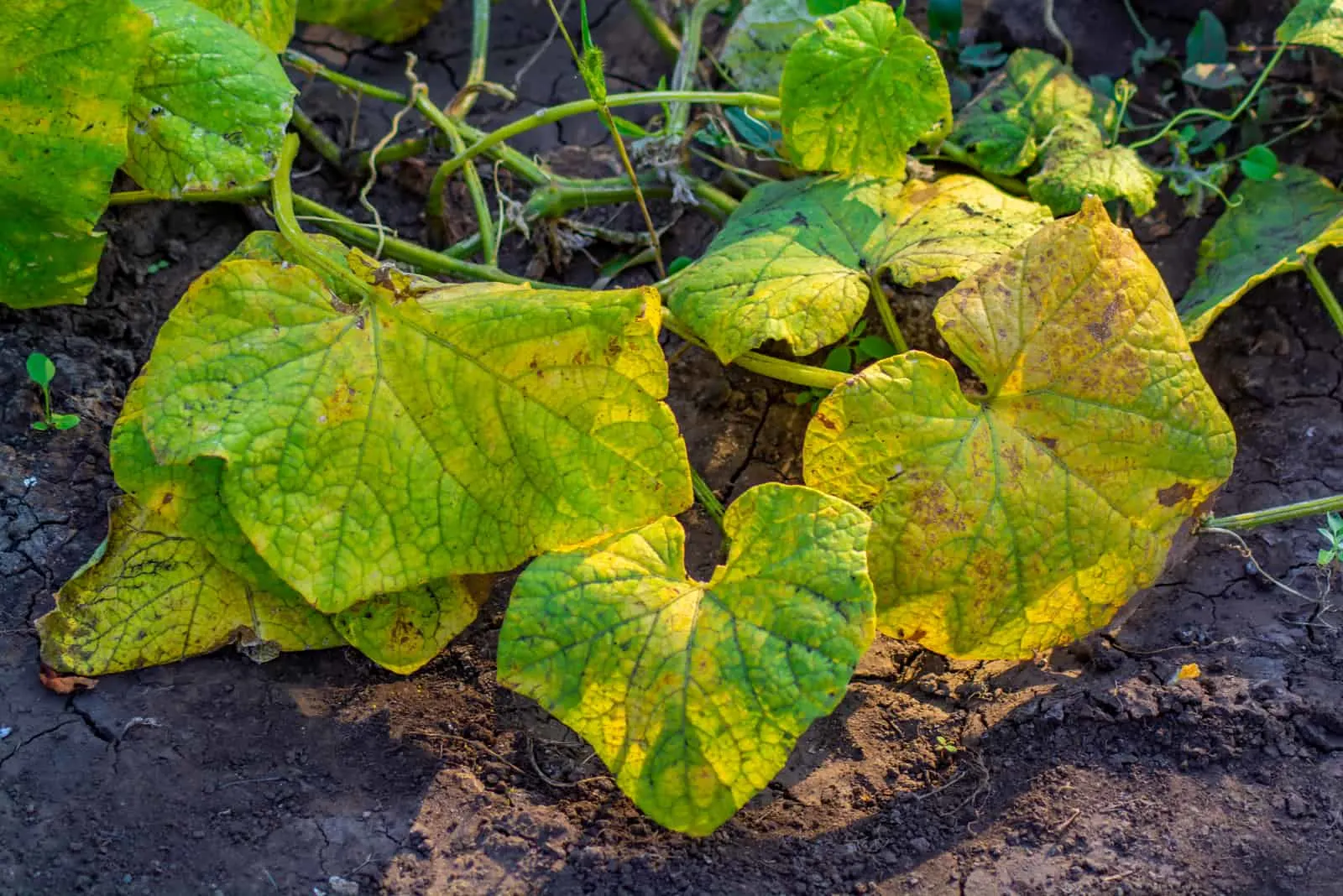
Inadequate sunlight can be one of the main reasons why cucumber leaves develop a yellow border. Cucumber plants need at least 6-8 hours of direct sunlight per day to thrive and produce healthy leaves. If your cucumber plants are not receiving enough sunlight, you may notice that the leaves start to turn yellow.
To address this issue, it is important to ensure that your cucumber plants are getting enough sunlight. Here are a few steps you can take:
- Choose a sunny location: When planting cucumber plants, choose a location that receives full sun for most of the day. Avoid planting them in shaded areas or near tall trees or buildings that may cast shadows.
- Trim surrounding plants: If nearby plants or vegetation are blocking sunlight from reaching the cucumber plants, consider trimming them back to allow more light to penetrate.
- Use reflective materials: You can maximize sunlight exposure by using reflective materials such as aluminum foil or white plastic sheets to redirect and amplify sunlight towards your cucumber plants.
- Consider container gardening: If you have limited space or poor sunlight conditions, you can try growing cucumbers in containers. This will allow you to move the plants around to ensure they receive optimal sunlight.
By providing adequate sunlight to your cucumber plants, you can help prevent yellowing of the leaves and promote healthy growth.
Environmental stress
Cucumber plants are susceptible to environmental stress, which can cause the leaves to develop a yellow border. It is important to identify and address the underlying issues to ensure the health and productivity of your plants.
1. Temperature fluctuations
Extreme temperature fluctuations can stress cucumber plants, leading to yellowing of the leaves. Cucumber plants prefer warm temperatures between 70-90°F (21-32°C). If the temperature drops below 50°F (10°C) or rises above 95°F (35°C), the plants may experience stress.
Protect your cucumber plants from temperature fluctuations by providing them with adequate shelter. You can use row covers or cloches to create a microclimate around the plants and shield them from extreme temperatures.
2. Inadequate watering
Inconsistent watering practices can also contribute to environmental stress in cucumber plants. Irregular watering or overwatering can cause the leaves to turn yellow. Cucumber plants require consistently moist but not waterlogged soil.
- Water cucumber plants deeply and evenly, providing around 1-2 inches of water per week.
- Monitor the moisture level of the soil regularly and adjust your watering schedule accordingly.
- Avoid overhead watering, as it can promote the development of fungal diseases. Water the plants at their base instead.
3. Nutrient deficiencies
Cucumber plants need a balanced supply of nutrients to thrive. Nutrient deficiencies, such as a lack of nitrogen, iron, or magnesium, can manifest as yellowing leaves with a distinct border.
Conduct a soil test to assess the nutrient levels in your garden. Based on the results, amend the soil with appropriate fertilizers or organic matter to correct any deficiencies. Regularly fertilize the cucumber plants throughout the growing season to ensure they receive an adequate nutrient supply.
4. Pests and diseases
Pests and diseases can also cause environmental stress in cucumber plants, leading to yellowing leaves. Common pests that affect cucumber plants include aphids, cucumber beetles, and spider mites. Diseases such as powdery mildew and bacterial wilt can also cause leaf discoloration.
Implement proper pest and disease management practices, such as maintaining good garden hygiene, using insecticidal soaps or organic pesticides, and removing infected plants to prevent the spread of diseases. Regularly inspect your cucumber plants for any signs of pests or diseases and take immediate action if necessary.
5. Overcrowding
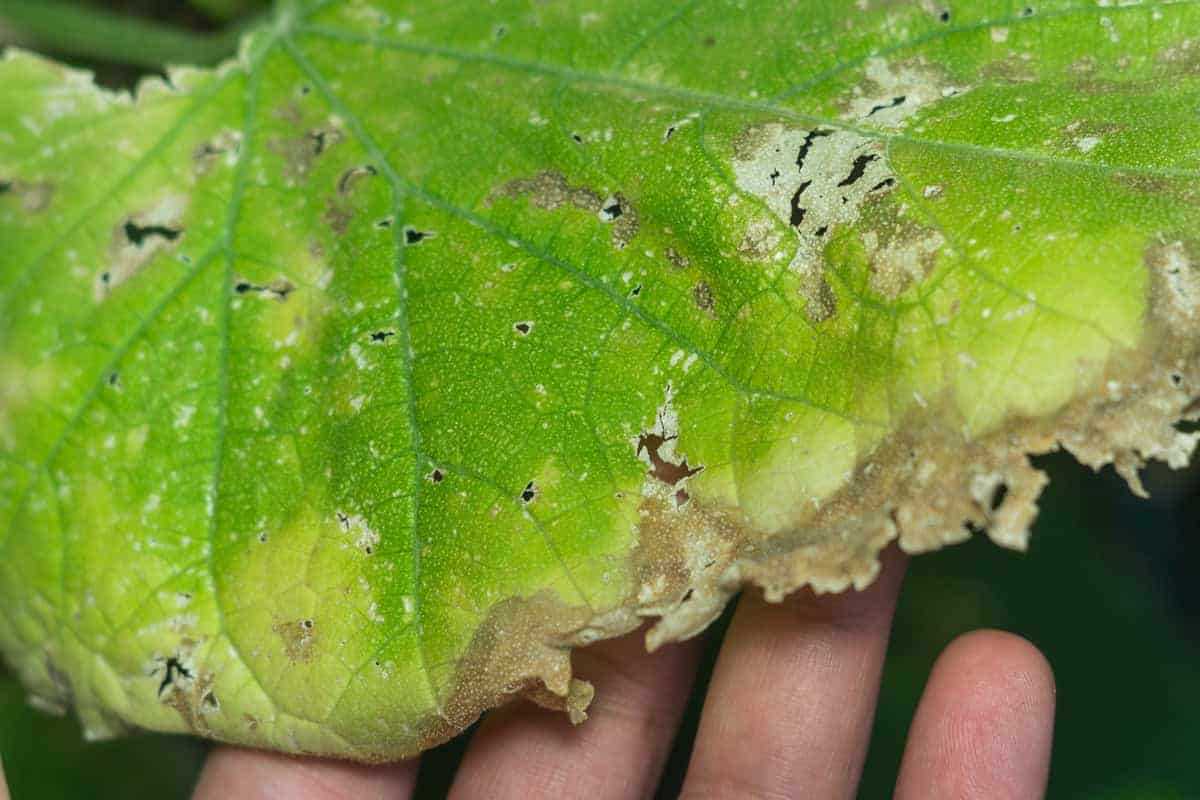
Overcrowding can contribute to environmental stress in cucumber plants. When plants are grown too close together, they compete for resources such as sunlight, water, and nutrients. This can result in nutrient deficiencies and reduced overall plant health.
Ensure proper spacing between cucumber plants to allow for adequate airflow and sunlight penetration. This will reduce the risk of environmental stress and promote healthier plant growth.
| Cause | Solution |
|---|---|
| Temperature fluctuations | Provide shelter and create a microclimate |
| Inadequate watering | Water deeply and evenly, avoid overwatering |
| Nutrient deficiencies | Conduct a soil test and fertilize accordingly |
| Pests and diseases | Implement pest and disease management practices |
| Overcrowding | Ensure proper spacing between plants |
Improper pruning
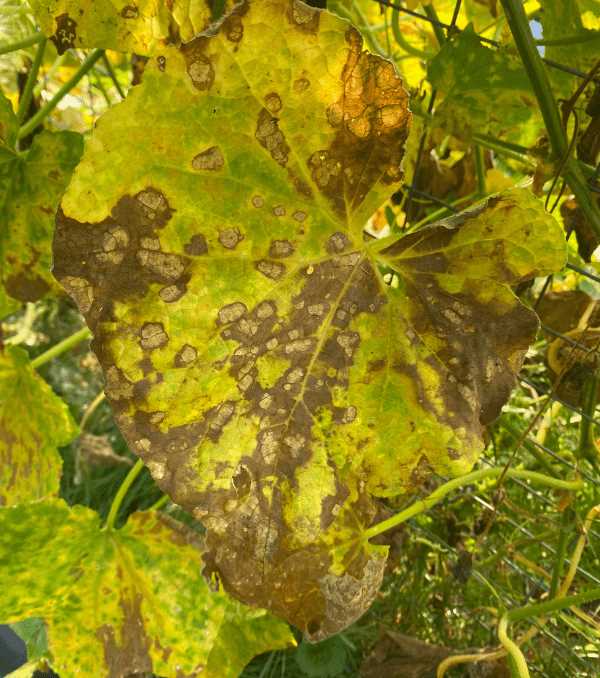
Improper pruning can contribute to yellow border development on cucumber leaves. When pruning cucumber plants, it’s essential to follow proper techniques to prevent stress and damage to the plant.
- Over-pruning: Pruning too aggressively can remove too many leaves, reducing the plant’s ability to photosynthesize. This can result in nutrient deficiencies and yellowing of the leaves. Avoid over-pruning by only removing the necessary amount of foliage.
- Pruning during unfavorable conditions: Pruning should be done during the plant’s active growth period and must be avoided during periods of extreme heat or drought. Pruning during these unfavorable conditions can stress the plant and lead to leaf discoloration.
It’s important to note that some pruning is necessary for cucumber plants to improve air circulation and reduce the risk of disease. However, it should be done judiciously and with care to prevent damage to the plant.
Solutions to yellowing cucumber leaves
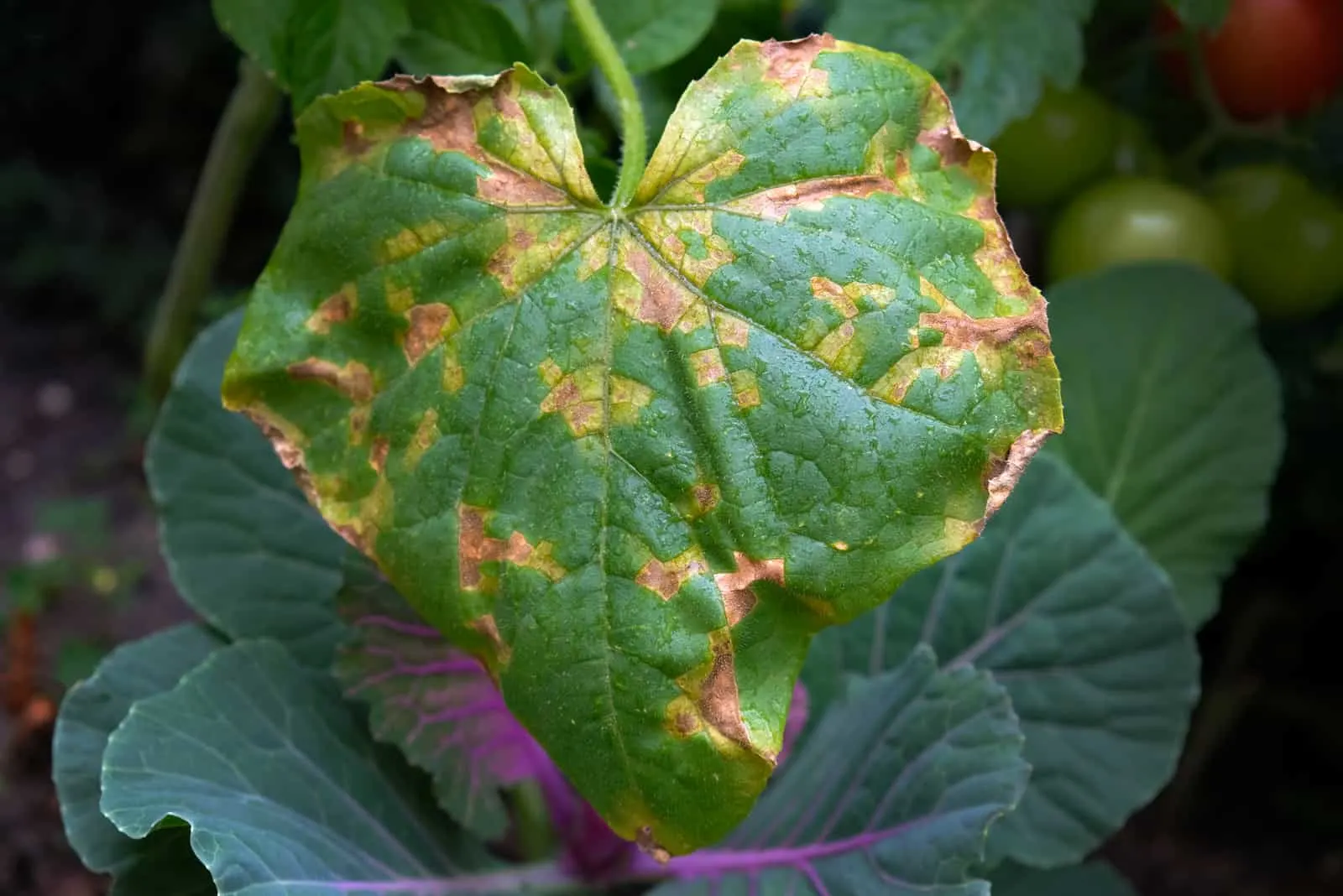
If your cucumber leaves have developed a yellow color, it is important to identify the cause and take appropriate action in order to prevent further damage to your plants. Here are some solutions you can try:
- Check for pests: Yellowing leaves can be a sign of pest infestation. Inspect your cucumber plants for any signs of aphids, spider mites, or other common cucumber pests. If you find any, treat the plants with an appropriate pesticide.
- Provide adequate watering: Underwatering or overwatering can cause stress to cucumber plants and lead to yellowing of leaves. Make sure your plants are receiving the right amount of water. Water them deeply, but allow the soil to dry out slightly between watering.
- Ensure proper nutrition: Yellowing leaves can indicate nutrient deficiencies, especially nitrogen deficiency. Apply a balanced fertilizer that is rich in nitrogen to replenish the nutrients in the soil and promote healthy foliage growth.
- Monitor light exposure: Insufficient sunlight or excessive heat can cause cucumber leaves to turn yellow. Ensure that your plants are receiving adequate sunlight, but also provide some shade during the hottest parts of the day to prevent stress.
- Prevent diseases: Cucumber plants can be susceptible to diseases such as powdery mildew, which can cause yellowing leaves. Use a fungicide to prevent or treat any fungal infections and ensure proper air circulation around the plants.
- Remove affected leaves: If the yellowing is localized to a few leaves, remove them to prevent the spread of any disease or pest infestations. Be sure to clean your tools between cuts to avoid cross-contamination.
By following these solutions, you can help your cucumber plants recover from yellowing leaves and promote healthy growth.
“Question-Answer”
Why are my cucumber leaves developing a yellow border?
The yellow border on cucumber leaves could be caused by a few factors. It could be a sign of nutrient deficiencies, such as nitrogen, magnesium, or iron. It could also be due to overwatering or poor drainage, which can lead to root problems and nutrient uptake issues. Lastly, it could be a symptom of a fungal or bacterial disease.
What should I do if my cucumber leaves have a yellow border?
If you notice a yellow border on your cucumber leaves, it’s important to take action. First, check the soil moisture and make sure it’s not too wet or too dry. Adjust the watering accordingly. Next, inspect the plant for signs of pests or diseases. If you suspect a nutrient deficiency, consider using a balanced fertilizer or organic amendments to provide the necessary nutrients. It’s also a good idea to remove any affected leaves and monitor the plant closely for further changes.
How can I determine if the yellow border on my cucumber leaves is due to a nutrient deficiency?
To determine if the yellow border on your cucumber leaves is caused by a nutrient deficiency, you can conduct a soil test. This will help identify any imbalances or deficiencies in the soil. Additionally, you can look for other symptoms of nutrient deficiencies, such as yellowing in other parts of the plant, stunted growth, or poor fruit development. If you suspect a nutrient deficiency, it’s best to address it promptly to ensure your plant’s health.
Can overwatering cause a yellow border on cucumber leaves?
Yes, overwatering can potentially cause a yellow border on cucumber leaves. When the soil is consistently wet, it can lead to poor drainage and root problems. This can interfere with the plant’s ability to absorb nutrients properly, resulting in yellowing leaves. To tackle this issue, it’s important to adjust your watering practices and ensure that the soil is well-drained. Allow the soil to dry out slightly between waterings and avoid excessive watering.
Is it possible for a yellow border on cucumber leaves to be a symptom of a disease?
Yes, a yellow border on cucumber leaves can be a symptom of a disease. Fungal and bacterial diseases, such as angular leaf spot or bacterial leaf spot, can cause yellowing along the edges of the leaves. These diseases are often accompanied by other symptoms like spots, lesions, or wilting. If you suspect a disease, it’s important to identify the specific pathogen and take appropriate measures to manage and control it.
How can I prevent a yellow border on my cucumber leaves?
To prevent a yellow border on cucumber leaves, it’s essential to maintain proper plant care. Start by ensuring that your plants receive adequate sunlight, water, and nutrients. Avoid overwatering and provide well-drained soil to prevent root problems. Regularly inspect your plants for signs of pests or diseases and take action if necessary. Additionally, practicing good garden hygiene by removing any infected leaves or debris can help prevent the spread of diseases.
Are there any natural remedies I can use to treat a yellow border on cucumber leaves?
Yes, there are natural remedies you can use to treat a yellow border on cucumber leaves. For nutrient deficiencies, you can use organic amendments like compost or well-decomposed manure to provide the necessary nutrients. Additionally, foliar sprays of diluted compost or seaweed extract can help improve nutrient uptake. For fungal or bacterial diseases, organic fungicides or bactericides made from plant extracts like neem oil or copper sulfate can be used. However, it’s important to properly identify the issue before choosing a treatment method.







